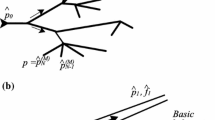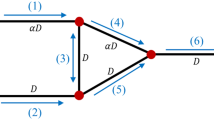Abstract
A planar flow network consisting of successive generations of bifurcating vessels located downstream from a single mother vessel containing an incident fully developed flow is investigated. The theory and analysis developed which are for relatively thin vessels apply to small, medium or large networks. Although each successive bifurcation is in effect from a new mother vessel to two daughters, the networked system splits these into different types of bifurcation, the middle ones being inertial and the edge ones being viscous–inviscid in view of the wall conditions. The influences of network shapes, topology and end-pressure differences on the flow ahead of and inside the network are examined. Distinct local and global forms of upstream influence are active. The effects are especially marked in terms of non-symmetry, which leads to a global upstream influence, displaces the whole incident flow and particularly affects the motions near the outermost walls; there the non-symmetrical effects govern the induced wall shear stress and pressure and the solution dependence is very sensitive because of the realistic incident flow. Results from lattice-Boltzmann simulations are also described, and comparisons are then made with the theory and analysis. Pressure and shape control are considered in detail.
Similar content being viewed by others
References
Pries AR, Secomb TW, Gaehtgens P (1998) Structural adaptation and stability of microvasular networks:theory and simulations. Am J Physiol Heart Circ Physiol 275: H349–H360
Hademenos GJ, Massoud TF, Viñuela F (1996) A biomathematical model of intracranial arteriovenous malformations based on electrical network analysis. Neurosurgery 38: 1005–1015
Goldman D, Popel AS (2000) A computational study of the effect of capillary network anastomoses and tortuosity on oxygen transport. J Theor Biol 206(2): 181–194
Brada M, Kitchen ND (2000) How effective is radiosurgery for arteriovenous malformations. J Neurol Neurosurg Psychiatry 68: 548–549
McEvoy AW, Kitchen ND, Thomas DGT (2000) Intracerebral haemorrhage in young adults:the emergence of drug misuse. B Med J 320: 1322–1324
Smith FT, Jones MA (2000) One-to-few and one-to-many branching tube flows. J Fluid Mech 423: 1–31
Smith FT, Jones MA (2003) AVM Modelling by multi-branching tube flow:large flow rates and dual solutions. Math Med Biol 20: 183–204
Young WL, Kader A, Pile-Spellman J, Ornstein E, Stein BM (1996) Arteriovenous malformation drawing vein physiology and determinants of transnidal pressure gradients. Neurosurgery 35: 389–396
Gao E, Young WL, Pile-Spellman J, Joshi S, Duong H, Stieg PE, Ma Q (1997) Cerebral arteriovenous malformations feeding artery aneurysms:a theoretical model of intravascular pressure changes after treatment. Neurosurgery 41: 1345–1358
Hademenos GJ, Massoud TF (1997) Biophysical mechanisms of stroke. Stroke 28: 2067–2077
Zhao Y, Brunskill CT, Lieber BB (1997) Inspiratory and expiratory steady flow analysis in a model symmetrically bifurcating airway. J Biomech Eng 119(1): 52–58
Wilquem F, Degrez G (1997) Numerical modelling of steady inspiratory airflow through a three-generation model of the human central airways. J Biomech Eng 119(1): 59–65
Liu Y, So RM, Zhang CH (2003) Modeling the bifurcating flow in an asymmetric human lung airway. J Biomech 36(7): 951–959
Kassab GS, Schatz A, Imoto K, Fung Y-C (2000) Remodeling of the bifurcation asymmetry of the right coronary ventricular branches in hypertrophy. Ann Biomed Eng 28(4): 424–430
Lorthois S, Lagree P-Y, Marc-Vergnes J-P, Cassot F (2000) Maximal wall shear stress in arterial stenoses:application to the internal carotid arteries. J Biomech Eng 122(6): 661–666
Comer JK, Kleinstreuer C, Zhang Z (2001) Flow structures and particle deposition patterns in double-bifurcation airway models. Part 1:air flow fields. J Fluid Mech 435: 25–54
Cassidy KJ, Gavriely N, Grotberg JB (2001) Liquid plug flow in straight and bifurcating tubes. J Biomech Eng 123(6): 580–589
Resnick N, Einav S, Chen-Konak L, Zilberman M, Yahav H, Shay-Salit A (2004) Haemodynamic forces as a stimulus for arteriogenesis. Endothelium 10: 197–206
Alarcon T, Byrne HM, Maini PK (2005) A design principle for vascular beds:the effects of complex blood rheology. Microvascular Res 69: 156–172
Bowles RI, Dennis SCR, Purvis R, Smith FT (2005) Multi-branching flows from one mother tube to many daughter or to a network. Phil Trans Roy Soc A 363: 1045–1055
Tadjfar M, Smith FT (2004) Direct simulations and modelling of basic three-dimensional bifurcating tube flows. J Fluid Mech 519: 1–32
Smith FT, Ovenden NC, Franke PT, Doorly DJ (2003) What happens to pressure when a flow enters a side branch. J Fluid Mech 479: 231–258
Smith FT, Dennis SCR, Jones MA, Ovenden NC, Purvis R, Tadjfar M (2003) Fluid flows through various branching tubes. J Eng Maths 47: 277–298
Smith FT (1977) Upstream interactions in channel flows. J Fluid Mech 79: 631–655
Smith FT (1976) On entry-flow effects in bifurcating, blocked or constricted tubes. J Fluid Mech 78: 709–736
Brotherton-Ratcliffe RV (1987) Boundary layer effects in liquid layer flows. Ph.D. Thesis, University of London
Chen S, Doolen GD (1998) Lattice Boltzmann method for fluid flows. Ann Rev Fluid Mech 30: 329–364
Wolf-Gladrow DA (2000) Lattice-gas cellular automata and lattice Boltzmann models. Springer
Succi S (2001) The lattice Boltzmann equation for fluid dynamics and beyond. Oxford Science Publication
He X, Luo LS (1997) Lattice Boltzmann model for the incompressible Navier–Stokes equations. J Stat Phys 88(3/4): 927
Bhatnagar P, Gross E, Krook M (1954) A model for collision processes in gases I:small amplitude processes in charged and neutral one-component system. Phys Rev 94: 511
Zou Q, He X (1997) On pressure and velocity boundary conditions for the lattice Boltzmann BGK model. Phys Fluids 9: 1591
Smith FT, Duck PW (1980) On the severe nonsymmetric constriction, curving and cornering of channel flows. J Fluid Mech 90: 727–753
Author information
Authors and Affiliations
Corresponding author
Rights and permissions
About this article
Cite this article
Ovenden, N., Smith, F. & Wu, G.X. The effects of nonsymmetry in a branching flow network. J Eng Math 63, 213–239 (2009). https://doi.org/10.1007/s10665-008-9232-4
Received:
Accepted:
Published:
Issue Date:
DOI: https://doi.org/10.1007/s10665-008-9232-4




